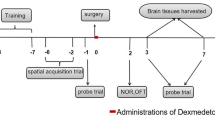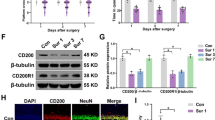Abstract
Neuroinflammation and oxidative stress coexist and interact in the progression of postoperative cognitive dysfunction (POCD) and other neurodegenerative disease. Mounting studies reveal that Dexmedetomidine (Dex) possesses anti-inflammatory and antioxidant properties. Nevertheless, whether Dex exerts neuroprotective effect on the cognitive sequelae of oxidative stress and inflammatory process remains unclear. A mouse model of abdominal exploratory laparotomy-induced cognitive dysfunction was employed to explore the underlying mechanism of neuroprotective effects exerted by Dex in POCD. Aged mice were treated with Dex (20 µg/kg) 20 min prior to surgery. Open field test (OFT) and Morris water maze (MWM) were employed to examine the cognitive function on postoperative day 3 (POD 3) or POD 7. In the present study, mice underwent surgery exhibited cognitive impairment without altering spontaneous locomotor activity, while the surgery-induced cognitive impairment could be alleviated by Dex pretreatment. Dex inhibited surgery-induced pro-inflammatory cytokines accumulation and microglial activation in the hippocampi of mice. Furthermore, Dex decreased MDA levels, enhanced SOD activity, modulated CDK5 activity and increased BDNF expression in the hippocampus. In addition, Dex remarkably reduced the surgery-induced increased ratio of Bax/Bcl-2 and apoptotic neurons in the hippocampi of aged mice. Collectively, our study provides evidence that Dex may exert neuroprotective effects against surgery-induced cognitive impairment through mechanisms involving its anti-inflammatory and antioxidant properties, as well as the suppression on the mitochondrial permeability transition pore and apoptosis-related pathway.







Similar content being viewed by others
Data Availability
Data will be made available on reasonable request.
References
Shoair OA et al (2015) Incidence and risk factors for postoperative cognitive dysfunction in older adults undergoing major noncardiac surgery: a prospective study. J Anaesthesiol Clin Pharmacol 31(1):30–36
Infante-Duarte C et al (2008) New developments in understanding and treating neuroinflammation. J Mol Med (Berl) 86(9):975–985
Gao HM, Hong JS (2008) Why neurodegenerative diseases are progressive: uncontrolled inflammation drives disease progression. Trends Immunol 29(8):357–365
Skaper SD (2007) The brain as a target for inflammatory processes and neuroprotective strategies. Ann NY Acad Sci 1122:23–34
Lin MT, Beal MF (2006) Mitochondrial dysfunction and oxidative stress in neurodegenerative diseases. Nature 443(7113):787–795
Singh A et al (2019) Oxidative stress: a key modulator in neurodegenerative diseases. Molecules 24(8):1583
Tarafdar A, Pula G (2018) The role of NADPH oxidases and oxidative stress in neurodegenerative disorders. Int J Mol Sci 19(12):3824
Sa-Nguanmoo P et al (2017) SGLT2-inhibitor and DPP-4 inhibitor improve brain function via attenuating mitochondrial dysfunction, insulin resistance, inflammation, and apoptosis in HFD-induced obese rats. Toxicol Appl Pharmacol 333:43–50
Godbout JP et al (2005) Exaggerated neuroinflammation and sickness behavior in aged mice following activation of the peripheral innate immune system. FASEB J 19(10):1329–1331
Li Y et al (2015) Effect of dexmedetomidine on early postoperative cognitive dysfunction and peri-operative inflammation in elderly patients undergoing laparoscopic cholecystectomy. Exp Ther Med 10(5):1635–1642
Zhu YJ et al (2016) Attenuation of neuroinflammation by dexmedetomidine is associated with activation of a cholinergic anti-inflammatory pathway in a rat tibial fracture model. Brain Res 1644:1–8
Xiang H et al (2014) Dexmedetomidine controls systemic cytokine levels through the cholinergic anti-inflammatory pathway. Inflammation 37(5):1763–1770
Zhu YS et al (2019) Dexmedetomidine protects rats from postoperative cognitive dysfunction via regulating the GABA(B) R-mediated cAMP-PKA-CREB signaling pathway. Neuropathology 39(1):30–38
Endesfelder S et al (2017) Neuroprotective effects of dexmedetomidine against hyperoxia-induced injury in the developing rat brain. PLoS One 12(2):e0171498
Li F et al (2018) Dexmedetomidine reduces oxidative stress and provides neuroprotection in a model of traumatic brain injury via the PGC-1α signaling pathway. Neuropeptides 72:58–64
Barrientos RM et al (2012) Intracisternal interleukin-1 receptor antagonist prevents postoperative cognitive decline and neuroinflammatory response in aged rats. J Neurosci 32(42):14641–14648
Ning Q et al (2017) Neurodegenerative changes and neuroapoptosis induced by systemic lipopolysaccharide administration are reversed by dexmedetomidine treatment in mice. Neurol Res 39(4):357–366
Li J et al (2019) Both GSK-3beta/CRMP2 and CDK5/CRMP2 pathways participate in the protection of dexmedetomidine against propofol-induced learning and memory impairment in neonatal rats. Toxicol Sci 171:193–210
Vorhees CV, Williams MT (2006) Morris water maze: procedures for assessing spatial and related forms of learning and memory. Nat Protoc 1(2):848–858
Ren L et al (1999) Differential expression of inflammatory mediators in rat microglia cultured from different brain regions. Brain Res Mol Brain Res 65(2):198–205
Yan J et al (2019) The role of SIRT1 in neuroinflammation and cognitive dysfunction in aged rats after anesthesia and surgery. Am J Transl Res 11(3):1555–1568
Xu J et al (2017) Astrocyte-derived CCL2 participates in surgery-induced cognitive dysfunction and neuroinflammation via evoking microglia activation. Behav Brain Res 332:145–153
McLinden KA, Trunova S, Giniger E (2012) At the fulcrum in health and disease: Cdk5 and the balancing acts of neuronal structure and physiology. Brain Disord Ther 2012(Suppl 1):001
Watamura N et al (2016) Colocalization of phosphorylated forms of WAVE1, CRMP2, and tau in Alzheimer’s disease model mice: involvement of Cdk5 phosphorylation and the effect of ATRA treatment. J Neurosci Res 94(1):15–26
Hawasli AH et al (2007) Cyclin-dependent kinase 5 governs learning and synaptic plasticity via control of NMDAR degradation. Nat Neurosci 10(7):880–886
Bath KG, Akins MR, Lee FS (2012) BDNF control of adult SVZ neurogenesis. Dev Psychobiol 54(6):578–589
Benraiss A et al (2001) Adenoviral brain-derived neurotrophic factor induces both neostriatal and olfactory neuronal recruitment from endogenous progenitor cells in the adult forebrain. J Neurosci 21(17):6718–6731
Sun YB et al (2019) Dexmedetomidine inhibits astrocyte pyroptosis and subsequently protects the brain in in vitro and in vivo models of sepsis. Cell Death Dis 10(3):167
Zhang Y et al (2019) Dexmedetomidine promotes hippocampal neurogenesis and improves spatial learning and memory in neonatal rats. Drug Des Dev Ther 13:4439–4449
Gao J et al (2019) Dexmedetomidine modulates neuroinflammation and improves outcome via alpha2-adrenergic receptor signaling after rat spinal cord injury. Br J Anaesth 123(6):827–838
Wang Y, Jia A, Ma W (2019) Dexmedetomidine attenuates the toxicity of β-amyloid on neurons and astrocytes by increasing BDNF production under the regulation of HDAC2 and HDAC5. Mol Med Rep 19(1):533–540
Ni P et al (2019) Preoperative sleep disturbance exaggerates surgery-induced neuroinflammation and neuronal damage in aged mice. Mediat Inflamm 2019:8301725
Rosczyk HA, Sparkman NL, Johnson RW (2008) Neuroinflammation and cognitive function in aged mice following minor surgery. Exp Gerontol 43(9):840–846
Brandeis R, Brandys Y, Yehuda S (1989) The use of the Morris Water Maze in the study of memory and learning. Int J Neurosci 48(1–2):29–69
Gelders G, Baekelandt V, Van der Perren A (2018) Linking neuroinflammation and neurodegeneration in Parkinson’s disease. J Immunol Res 2018:4784268
Calsolaro V, Edison P (2016) Neuroinflammation in Alzheimer’s disease: current evidence and future directions. Alzheimers Dement 12(6):719–732
Liu J, Wang F (2017) Role of neuroinflammation in amyotrophic lateral sclerosis: cellular mechanisms and therapeutic implications. Front Immunol 8:1005
Da SD et al (2016) Decreased toll-like receptor 2 and toll-like receptor 7/8-induced cytokines in Parkinson’s disease patients. Neuroimmunomodulation 23(1):58–66
Feng X et al (2017) Microglia mediate postoperative hippocampal inflammation and cognitive decline in mice. JCI Insight 2(7):e91229
Wei P et al (2019) The potential role of the NLRP3 inflammasome activation as a link between mitochondria ROS generation and neuroinflammation in postoperative cognitive dysfunction. Front Cell Neurosci 13:73
Khan MS et al (2016) Anthocyanins protect against LPS-induced oxidative stress-mediated neuroinflammation and neurodegeneration in the adult mouse cortex. Neurochem Int 100:1–10
Yatin SM, Varadarajan S, Butterfield DA (2000) Vitamin E prevents Alzheimer’s amyloid beta-peptide (1–42)-induced neuronal protein oxidation and reactive oxygen species production. J Alzheimers Dis 2(2):123–131
Rimessi A et al (2016) Mitochondrial reactive oxygen species and inflammation: molecular mechanisms, diseases and promising therapies. Int J Biochem Cell Biol 81(Pt B):281–293
Eren I, Naziroğlu M, Demirdaş A (2007) Protective effects of lamotrigine, aripiprazole and escitalopram on depression-induced oxidative stress in rat brain. Neurochem Res 32(7):1188–1195
Zhang W et al (2020) Dexmedetomidine attenuates glutamate-induced cytotoxicity by inhibiting the mitochondrial-mediated apoptotic pathway. Med Sci Monit 26:e922139
Huang J, Jiang Q (2019) Dexmedetomidine protects against neurological dysfunction in a mouse intracerebral hemorrhage model by inhibiting mitochondrial dysfunction-derived oxidative stress. J Stroke Cerebrovasc Dis 28(5):1281–1289
Netto MB et al (2018) Oxidative stress and mitochondrial dysfunction contributes to postoperative cognitive dysfunction in elderly rats. Brain Behav Immun 73:661–669
Seo J et al (2017) Inhibition of p25/Cdk5 attenuates tauopathy in mouse and iPSC models of frontotemporal dementia. J Neurosci 37(41):9917–9924
Gutiérrez-Vargas JA, Múnera A, Cardona-Gómez GP (2015) CDK5 knockdown prevents hippocampal degeneration and cognitive dysfunction produced by cerebral ischemia. J Cereb Blood Flow Metab 35(12):1937–1949
Pfänder P et al (2019) Cdk5 deletion enhances the anti-inflammatory potential of GC-mediated GR activation during inflammation. Front Immunol 10:1554
Sundaram JR et al (2012) Cdk5/p25-induced cytosolic PLA2-mediated lysophosphatidylcholine production regulates neuroinflammation and triggers neurodegeneration. J Neurosci 32(3):1020–1034
Patrick GN et al (1998) p35, the neuronal-specific activator of cyclin-dependent kinase 5 (Cdk5) is degraded by the ubiquitin-proteasome pathway. J Biol Chem 273(37):24057–24064
Liu SL et al (2016) The role of Cdk5 in Alzheimer’s disease. Mol Neurobiol 53(7):4328–4342
Hu Y, Pan S, Zhang HT (2017) Interaction of Cdk5 and cAMP/PKA signaling in the mediation of neuropsychiatric and neurodegenerative diseases. Adv Neurobiol 17:45–61
Lu B, Nagappan G, Lu Y (2014) BDNF and synaptic plasticity, cognitive function, and dysfunction. Handb Exp Pharmacol 220:223–250
Fan D et al (2016) Enriched environment attenuates surgery-induced impairment of learning, memory, and neurogenesis possibly by preserving BDNF expression. Mol Neurobiol 53(1):344–354
Bogush A et al (2007) AKT and CDK5/p35 mediate brain-derived neurotrophic factor induction of DARPP-32 in medium size spiny neurons in vitro. J Biol Chem 282(10):7352–7359
Fang QJ et al (2020) Surgery-induced downregulation of hippocampal sirtuin-1 contributes to cognitive dysfunction by inhibiting autophagy and activating apoptosis in aged mice. Am J Transl Res 12(12):8111–8122
Hockenbery DM et al (1993) Bcl-2 functions in an antioxidant pathway to prevent apoptosis. Cell 75(2):241–251
Park JR, Hockenbery DM (1996) BCL-2, a novel regulator of apoptosis. J Cell Biochem 60(1):12–17
Dietrich JB (1997) Apoptosis and anti-apoptosis genes in the Bcl-2 family. Arch Physiol Biochem 105(2):125–135
Rohn TT et al (2008) Lack of pathology in a triple transgenic mouse model of Alzheimer’s disease after overexpression of the anti-apoptotic protein Bcl-2. J Neurosci 28(12):3051–3059
Author information
Authors and Affiliations
Contributions
XX and ZS: Investigation, Writing-Original draft preparation. CH and KZ: Methodology, Data curation. MG: Visualization, Software. FW and KQ: Writing-Reviewing and Editing.
Corresponding authors
Ethics declarations
Conflict of interest
The authors declare that they have no competing interests.
Additional information
Publisher’s Note
Springer Nature remains neutral with regard to jurisdictional claims in published maps and institutional affiliations.
Rights and permissions
About this article
Cite this article
Xie, X., Shen, Z., Hu, C. et al. Dexmedetomidine Ameliorates Postoperative Cognitive Dysfunction in Aged Mice. Neurochem Res 46, 2415–2426 (2021). https://doi.org/10.1007/s11064-021-03386-y
Received:
Revised:
Accepted:
Published:
Issue Date:
DOI: https://doi.org/10.1007/s11064-021-03386-y




